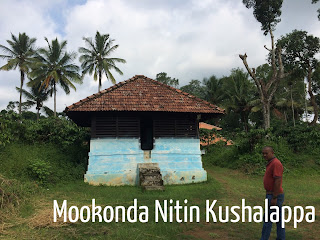My article was published under the title 'Deep in the land of Kodavas' on the second page of the Deccan Herald newspaper's supplementary copy Spectrum dated Tuesday, 29th September, 2015. See this link for more details :
http://www.deccanherald.com/content/503360/deep-land-kodavas.html
My special thanks to the Deccan Herald and the Mandetira family.
Original draft :
The meadow temple
"One morning I came to a temple place
known as Kakot Parambu near the town of Virajpet. A holy meadow,
called Parambu in the Kodava language and scenic for its
greenery, stretches over a hillock within a gateway and is visible
from the road. Before it stands a school ground and a ceremony hall.
At one side within the precincts is a small shrine dedicated to
Chavundi (Chamundi) while at the other side is the Kakot Achchayya
temple.
 |
| Chavundi shrine |
Legend has it that Kakot Achchayya and
his sister Kakot Akkavva walked to this place in the ancient times.
Kakot Achchayya, also known as Kombu Meeshe (Horn moustache)
Achchayya, had a man servant called Kari Kotta to attend to them.
They settled down here and a Mahadeva temple was built for them. Over
years the Kakot Achchayya shrine came to become known as the Kala
Bhairaveshwara temple.
The Kala Bhairaveshwara temple has a
horse figure representing the Kshetra Pala, guardian of the
region, overlooking it. Behind the Kala Bhairaveshwara shrine is the
temple of the Kodi Beera (war hero). This smaller shrine is
dedicated to an ancestor of the Mandetira family who had died a
violent death and who is represented by a rock placed upon a
platform. To the side of the main shrine is a large tree upon a
platform called the Kari-yappa Sthana. Beyond that is
the shrine of Akkavva which has a well nearby. Before the Akkavva
shrine is a tree with the small figure of a crane under it. Beside
this tree is a temple pond which also has a similar crane figurine by
its steps.
 |
| Temple pond |
The Mandetira family is the Deva
Takka of the temple. Deva Thakka family members are caretakers
who are responsible for the management of a temple. According to
their family tree, the earliest known Mandetira ancestor is one
Bogayya. His son Achchunna was the brother-in-law of Utta Nayaka of
Kadnur, a very powerful chieftain in the 1780s. Achchunna went into
Tulu naad (Dakshina Kannada) and sent an archak
(Brahmin priest) called Sankana from that land. Sankana and his
descendants, the Kukkemane
family, thereafter served as the priests of the Kakot temple.
Achchunna never returned, dying in that place. A memorial was built
for him there at Kodapada village in Dakshina Kannada.
 |
| Kodi Beera shrine, dedicated to Medayya |
During times of strife and conflict
Achchunna's son Medayya was beheaded by a king. A memorial, called
the Kodi Bira Sthana, was built for him at the place behind
the temple where his head fell. Medayya's young son Subbayya was the
last remaining member of his family. His widowed mother, who was from
the Iychettira family, brought him up.
 |
| Subbayya and Dodda Vira Rajendra |
Upon coming of age Subbayya joined the
Raja's government and was given his family property. A painting,
which shows him paying the Raja his respects, was commissioned in
1805. Subbayya remained in the government of the Kodagu Rajas for a
long while, serving under Dodda Vira Rajendra (r.1792-1807),
Devammaji (r.1807-1809), Linga Rajendra (r.1809-1820) and Chikka Vira
Rajendra (r.1820-1834). When the British took over the administration
of Kodagu in 1834, the native officers were all retained. Unlike his
father Medayya who had antagonised the ruling power of his times,
Subbayya had remained loyal to the Rajas and later to the British
under whom he came to earn a medallion and pension for three
generations. He later retired as Parupatyagara, a senior
government official.
 |
| Entrance |
Much of the family history has been
documented by the clan members. The Mandetira, the Kukkemane, the
Nellamakkada and a number of other families have helped renovate the
temple over generations. Every year ceremonial dances are held in the
Kakot Parambu mand (village green). In 2007, the Mandetira family
organised the annual Kodava Hockey tournament which was held in Kakot
Parambu that year.
 |
| Ainmane porch |
The Ainmane, ancestral home, of the
clan has a wooden portico and entrance wall. A family tree of the
Mandetiras is displayed by the entrance. The beautiful, but small and
old, painting depicting the Kodagu Raja Dodda Vira Rajendra
(r.1792-1807) and the ancestor Mandetira Subbayya is within a wooden
frame placed on the wall behind the hanging prayer lamp. The Kaimada,
a private shrine built in remembrance of clan ancestors, and a
sanctuary for El Koot Murthy (seven spirit-deities) are
located nearby.
 |
| Kaimada (Anil is standing beside it) |
During my visit, preparations for the
naming ceremony of Mr. Vinyas' child were going on in the ceremony
hall by the road. Mandetira Vinyas is the son of a clan elder Mr.
Nanjappa. Mr. Anil, another family member, showed me around the
place."
The Ammandira are the first Deva Thakka of the temple. The temple has been maintained by the families of the Nalkeri hamlet of Kakot Parambu, like the Ammandira, the Mandetira and many others. The Mandetira are the second Deva Thakka of the Kala Bhairaveshwara temple at Kakot Parambu. In 1999 Mandetira S. Uthappa had released a book called 'Mandetira family history'. The story of Kakot Achchayya, Kakot Akkavva and Kari-yanna Kotta is from the Pattole Palame. The mentioned family names of the Nellamakkada, the Kukkemane and the Mandetira are on the basis of the stone tableaux upon the walls of the temple which speak of the donations they made to the shrine.


